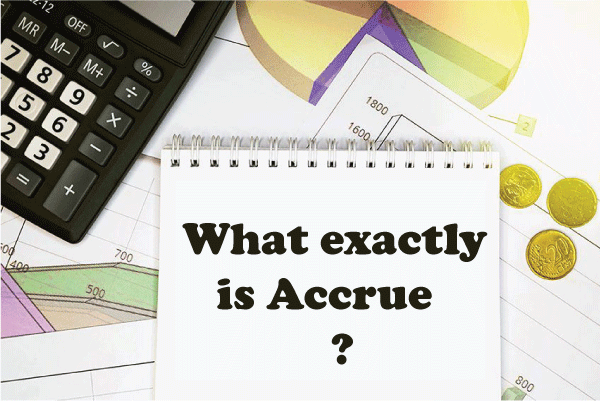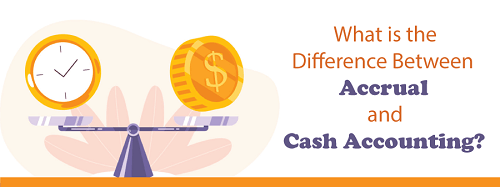Accrue: Definition, How It Works, and 2 Main Types of AccrualsWhat exactly is Accrue?The term 'accrue' refers to something that accumulates over time. It is usually used in relation to the interest, revenue or cost of an individual or business. Savings account interest, for example, accumulates over time, increasing the total amount in the account. 
Accrue is commonly used in connection with accrual accounting, which has become the standard accounting approach for most businesses. In-depth Understanding of AccrueWhen something accrues in financial terms, it usually continually increases or adds up to be paid or received in an upcoming specific period. Throughout time, both assets and liabilities can accumulate. Under the accounting system specified by Generally Accepted Accounting Principles (GAAP) and International Financial Reporting Standards (IFRS), the phrases "accrue" and "accrual" are somewhat identical. An accrual is an accounting adjustment used to monitor and record revenues that have occurred but not been received and expenses that have occurred but have not been paid so far. Consider accruing entries the inverse of unearned entries-the related financial event has already occurred. Money still needs to be paid or received. The Financial Accounting Standards Board (FASB), which interprets GAAP, establishes sufficient and obligatory accruals. Accounts payable and receivable, goodwill, future tax obligations, and future interest expenditure are all examples of accruals. What are the types of Accrues?All accruals are classified as either revenue or expense accruals, i.e.: 1. Accrued RevenueRevenue accruals are unreceived revenue or assets (including non-cash assets). These accruals arise when a corporation sells an item or service but does not receive payment from the consumer. Businesses that process a significant number of credit card transactions typically have high levels of accounts receivable and accrued revenue. Example 1 Consumption of power (or electricity) is one example of accrued revenue. Before collecting payment, an electrical firm normally supplies the utility to its customers. The customer consumes the electricity, and the meter records the usage. The consumer is billed after the billing period. Employees are paid, generators are fuelled, and logistical and monthly fees are incurred. Regardless of the cost of the month, the electrical business should receive its income at the end of the month. Meanwhile, the electrical provider must admit that it anticipates future revenue. Accrual accounting enables the business to keep track of its financial situation. When the firm receives payment from its clients at the end of the month, receivables decrease, and cash grows. Example 2 Suppose Business JTP engages Consulting Firm DGX to assist with a project that will take three months to complete. The price for this project is $150,000, payable upon completion. While JTP owes DGX $50,000 after each monthly milestone, the entire amount is paid after the completion of the project rather than in instalments. In this case, Company DGX records entries for accrued revenue in the amount of $150,000. 2. Accrued ExpenseWhen a company recognizes an expense before it is paid, it can record it in its general ledger as an accrual cost or expense. The expenditure might also be recorded as accumulated on the balance sheet and charged to income on the income statement. The following are examples of common categories of incurred expenses:
When unfulfilled commitments must be acknowledged in the financial statements, interest, taxes, and other payments must occasionally be included in accumulated entries. Alternatively, operational expenditures for a given period may be underestimated, resulting in an overstatement of net profits. Example 1 Consider a new firm JTP where an employee named Vijay works. Suppose Vijay is supposed to earn a substantial financial bonus after five years with the company. While working for the firm, Vijay becomes dedicated, hardworking and industrious. Let's say he now qualifies for a portion of his bonus each year. But, unlike cash payment at the time of accrual transaction, Vijay is not getting his bonus during individual years. Vijay, on the other hand, has seen his bonuses gradually rise. In parallel, Business JTP's responsibility to Vijay has grown. In this situation, Business JTP becomes a five-year debtor to Vijay. As a result, to appropriately report Vijay's incentives, the corporation must perform a bonus liability accrual to account for these bonus costs. When the business pays Vijay's overdue bonus, the transaction is recorded by debiting the liabilities account and crediting the cash account. Example 2 Suppose a company pays salaries on a monthly basis. A paycheck date, for example, may be January 28. Employees required to work on January 29, 30, or 31 will be compensated. Because such charges must still be accounted for on the current payroll, an accumulated salary account is used. Certain expenditures must be spent for several reasons. The basic goal of an accrual account is to match those costs to the accounting period in which they were incurred. Accrued costs also help in estimating the future expenses of the organization accurately. What is the difference between Accrual and Cash Accounting?
Cash accounting is often favoured over accrual accounting. However, cash accounting can give an inaccurate picture of an entity's financial health, especially when unpaid expenditures or outstanding receivables are not recorded in the financial statements. Since it provides a more accurate view of a company's financial status, accrual accounting becomes important in large and complicated commercial entities. A common example is a construction business that may obtain a long-term construction project only receiving full cash payment once the job is completed. In cash accounting, the corporation would record several costs throughout construction. Still, it would only receive revenue once the project is completed (assuming no milestone payments). As a result, until the cash payment is made, the company's financials will reflect losses. Because of its costs and lack of revenue, a lender, for example, may not deem the firm creditworthy. In comparison, the construction business may realize a share of revenue and expenditures corresponding to the proportion of work done under the accrual accounting approach. It may show a profit or a loss in each financial period while the project is still operational. The procedure is known as the percentage of completion approach. Even if the corporation used the accrual method, the cash flow statement would provide a fair picture of the actual cash flow. The accrual method would give the prospective lender an accurate representation of the company's income stream. What is the role of the Accounting Method in Taxation?The proper taxation authority normally requires taxpayers to continuously utilize the form of accounting that accurately depicts the entity's genuine revenue. Switching accounting procedures might generate loopholes for a firm to alter income and lower tax liabilities. Cash accounting is often permitted for sole proprietorships and small enterprises. Large enterprises, on the other hand, often employ accrual accounting when completing their tax returns. Important Things to ConsiderThe accrual accounting method analyses a company's performance and position by recognizing economic events regardless of when cash transactions take place, resulting in a more accurate picture of the company's financial health and causing asset or liability changes to "build up" over time. On the other hand, the cash method of accounting captures revenues and expenditures only when they are paid or received, leaving out revenue based on credit and future commitments. Adjustments are not required in cash-based accounting. While some small or new firms employ cash accounting, most organizations use accrual accounting. Accrual accounting provides a considerably more accurate picture of a company's financial status than cost accounting since it tracks current and future activities. If a firm sells $100 worth of merchandise on credit in January, for example, it would want to record that $100 using the accrual accounting technique rather than waiting until the payment is collected, which may take months or possibly create a bad debt. The Bottom LineEven though the cash has not yet exchanged hands, accruals affect a company's bottom line and help reflect a true picture of a company's financial position. According to GAAP, the accrual method of accounting is the preferred approach. It entails making adjustments for income received but still needs to be recorded and costs incurred but not yet recorded by adjusting journal entries at the end of the accounting period. Accruals are important because they ensure that a company's financial statements accurately reflect its financial situation. |
 For Videos Join Our Youtube Channel: Join Now
For Videos Join Our Youtube Channel: Join Now
Feedback
- Send your Feedback to [email protected]
Help Others, Please Share









